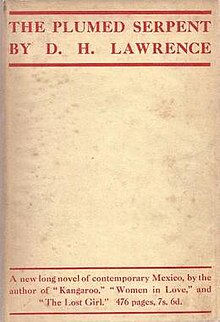The Plumed Serpent

Cover of the first edition
|
|
| Author | D. H. Lawrence |
|---|---|
| Cover artist | Dorothy Brett (for the first US edition, published by Knopf) |
| Language | English |
| Published | 1926 (Martin Secker) |
| Media type | Print (Hardcover and Paperback) |
| Pages | 445 (Vintage international edition) |
| ISBN | (Vintage international edition) |
The Plumed Serpent is a 1926 novel by D. H. Lawrence. Set in Mexico, it was begun when the author was living at what is now the D. H. Lawrence Ranch near Taos in the U.S. state of New Mexico in 1924, accompanied by his wife Frieda and artist Dorothy Brett. Lawrence wanted to call the book "Quetzalcoatl", after the Aztec god of that name, but his publisher Knopf found the name strange and insisted on "The Plumed Serpent", a title Lawrence disliked. An early draft of the book, different enough to be considered a distinct work, was published under the title "Quetzalcoatl" in 1995. Critics have seen The Plumed Serpent as having fascist overtones, and as expressing Lawrence's fears about the decline of the white race and belief in women's submission to men. The book has also been interpreted as an expression of Lawrence's personal political ambition.
The novel has a contemporary setting during the period of the Mexican Revolution. It opens with a group of tourists visiting a bullfight in Mexico City. One of them, Kate Leslie, departs in disgust and encounters Don Cipriano, a Mexican general. Later she meets his friend, an intellectual landowner Don Ramón, and travels to Sayula, a small town set on a lake. Ramón and Cipriano are leading a revival of a pre-Christian religion and Kate becomes drawn into their cult.
The cultural critic Philip Rieff described The Plumed Serpent as "a novel of pagan religiosity, raising the possibility of converting a Western woman to a primitive Indian cult." Rieff wrote that in his "imaginative rehabilitation" of Aztec ritual, Lawrence "rightly understands sun dancing as an imitation — or a dramatic representation — performed in substantiation of the divine concern with the human being", but concluded that The Plumed Serpent is an embarrassment even to Lawrence's admirers.
The feminist Kate Millett, writing in Sexual Politics (1969), described the "mood" of The Plumed Serpent as "homoerotic". Millett wrote that most of Lawrence novels include a "symbolically surrogate scene of pederasty", giving the "consecration scene" in The Plumed Serpent as an example. Millett suggested that The Plumed Serpent was a deservedly neglected novel, describing the book as "strident" and "unpleasant" because of Lawrence's "protofascist tone" and "fondness of force", his "arrogance" and his "racial, class, and religious bigotries." She maintained that the book showed Lawrence's search for triumph in politics and other areas of life, and that it records Lawrence's invention of a religion of "male supremacy", with its prose celebrating "phallic supremacy". Millett described Lawrence's character Kate Leslie as a "female impersonator".
...
Wikipedia
